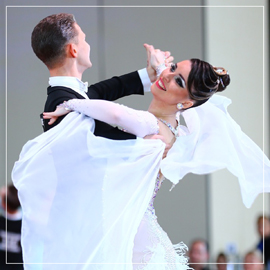 In the 16th century, one of the world’s most beloved forms of dance emerged: ballroom. Also sometimes referred to as “partnership dancing” as it must always be performed by two, it has come a long way since its origins in royal courts. The Waltz, an iconic type of ballroom dance that originated as an 18th century Austrian folk dance, serves as just one example of how the dance has transformed over the centuries. Ballroom dance continues to evolve to this day.
In the 16th century, one of the world’s most beloved forms of dance emerged: ballroom. Also sometimes referred to as “partnership dancing” as it must always be performed by two, it has come a long way since its origins in royal courts. The Waltz, an iconic type of ballroom dance that originated as an 18th century Austrian folk dance, serves as just one example of how the dance has transformed over the centuries. Ballroom dance continues to evolve to this day.
Two Styles of Ballroom Dance
 In the early 1800s, the International Style of ballroom dance developed in England. The popularity of the music of Josef and Johann Strauss helped spread this style all around the world by the 20th century. International Style can be divided into two main sub-styles: Standard, also known as “Ballroom,” and Latin, a flashy, technically demanding style popular on the competitive dance circuit. Here in the United States, ballroom dance adapted into the American Style between 1910 – 1930, mainly due to the influence of American jazz music, a more social approach to dancing and the iconic dance and choreography talents of Mr. Fred Astaire. Over the years, American Style has expanded to include dances such as Mambo, Salsa and West Coast Swing, and has always been driven by the constant development of music around the world. The American Style of ballroom dance is categorized into two distinct sub-styles: Rhythm and Smooth, and is used in both social and competitive ballroom dance arenas.
In the early 1800s, the International Style of ballroom dance developed in England. The popularity of the music of Josef and Johann Strauss helped spread this style all around the world by the 20th century. International Style can be divided into two main sub-styles: Standard, also known as “Ballroom,” and Latin, a flashy, technically demanding style popular on the competitive dance circuit. Here in the United States, ballroom dance adapted into the American Style between 1910 – 1930, mainly due to the influence of American jazz music, a more social approach to dancing and the iconic dance and choreography talents of Mr. Fred Astaire. Over the years, American Style has expanded to include dances such as Mambo, Salsa and West Coast Swing, and has always been driven by the constant development of music around the world. The American Style of ballroom dance is categorized into two distinct sub-styles: Rhythm and Smooth, and is used in both social and competitive ballroom dance arenas.
International & American Styles: Differences
 The International Style of ballroom dance retains much of what the world would recognize as classic or “old school” ballroom dance. In International Standard, partners must remain in “closed position,” meaning that they have to maintain body contact throughout the entire performance. Although American Smooth bears many similarities to this style, it does allow the dancers to separate in what’s called “open position”. This difference can be even be observed in the kinds of clothes the dancers wear. In International Style, dancers will typically wear gowns or dresses with floats on them to emphasize the gracefulness of their movement. In its American counterpart, however, dancers avoid such garments so that transitions between closed and open position can be more fluid.
The International Style of ballroom dance retains much of what the world would recognize as classic or “old school” ballroom dance. In International Standard, partners must remain in “closed position,” meaning that they have to maintain body contact throughout the entire performance. Although American Smooth bears many similarities to this style, it does allow the dancers to separate in what’s called “open position”. This difference can be even be observed in the kinds of clothes the dancers wear. In International Style, dancers will typically wear gowns or dresses with floats on them to emphasize the gracefulness of their movement. In its American counterpart, however, dancers avoid such garments so that transitions between closed and open position can be more fluid.
Due to the freedom offered in American Smooth, beginning dancers often find it easier to learn at first than International Style. Nonetheless, at the most advanced levels, both styles demand much dedication and discipline
Ready to get your dance on?
At Fred Astaire Dance Studios, our instructors teach International Style, American Style, and much, much more! Does one sound more appealing than the other? No worries – as a Fred Astaire dance student, you choose which dance style you’d like to learn first based on your interests and unique dance goals. For example, prospective students interested in high-energy lessons to improve their fitness and endurance would likely choose a different style than couples looking for an elegant First Dance for their wedding. Whether you’re young, old, inexperienced, seasoned, solo, or with a significant other – you are welcome to learn and dance with us!
Want to learn more about the types of ballroom dance? Feel free to continue browsing the resources on our site or view a demonstration video by clicking on the links on the right. Then, be sure to give us a call at Fred Astaire Dance Studios. Don’t forget to ask about our money-saving introductory offer for newcomers! Together, we’ll get you well on your way on your personal dance journey.
